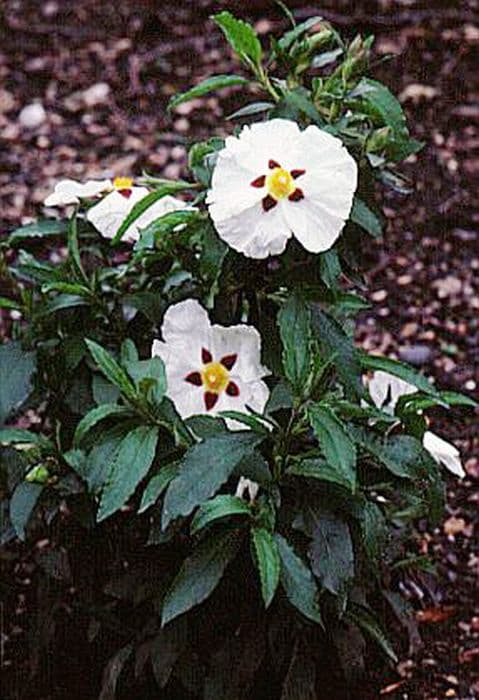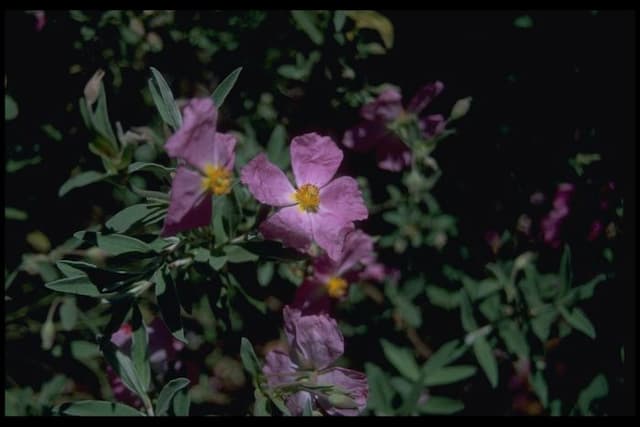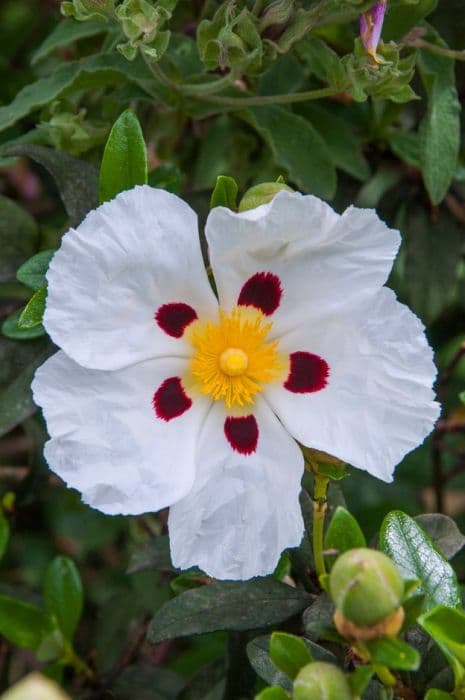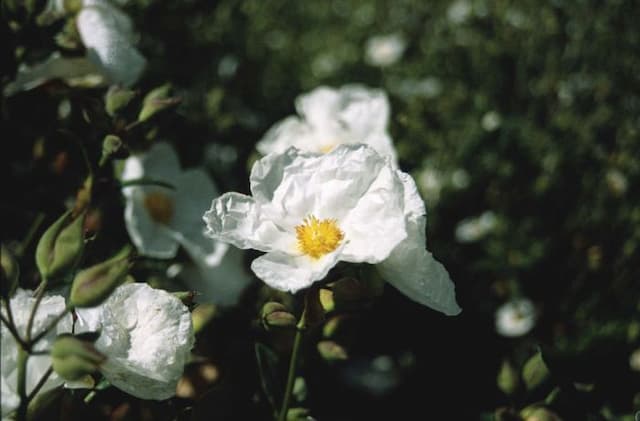Rock Rose Helianthemum 'Wisley Primrose'

ABOUT
Wisley Primrose is a charming plant that features a mat-forming growth habit, which creates a lush, low-lying ground cover. The foliage consists of small, green leaves that are lance-shaped and slightly fuzzy, providing a soft-textured appearance throughout the year. During the blooming season, Wisley Primrose showcases an abundance of cheerful, primrose-yellow flowers, which add a bright spot of color to any garden setting. The blooms are saucer-shaped with a distinctive arrangement of petals, and they often attract butterflies and other beneficial insects. Each flower has a center made up of a cluster of delicate stamens that offer a subtle contrast to the yellow petals. The overall impression of Wisley Primrose is one of a delightful, sun-loving plant with a showy floral display, perfect for adding warmth and brightness to rock gardens, borders, and sunny open areas.
About this plant
 Names
NamesFamily
Cistaceae
Synonyms
Rock Rose, Sunrose, Helen's Flower, Common Rockrose
Common names
Helianthemum 'Wisley Primrose'
 Toxicity
ToxicityTo humans
Rock rose is generally considered non-toxic to humans. There is no widespread documentation of toxicity or poisonous effects from ingesting parts of this plant. However, like with any plant material, individual allergies or sensitivities can occur. If any adverse reaction is noticed after ingestion, it is advisable to seek medical attention.
To pets
Rock rose is not commonly listed as toxic to pets. There is no widely available information to suggest that ingestion of this plant poses a significant risk to animals. Nevertheless, it's always prudent to monitor pets if they consume any plant matter, as individual animals might react differently, and gastrointestinal issues can occur from ingesting non-food items. If you notice any signs of distress in your pet after ingestion, consulting a veterinarian would be advisable.
 Characteristics
CharacteristicsLife cycle
Perennials
Foliage type
Evergreen
Color of leaves
Green
Flower color
Yellow
Height
1 foot (30 cm)
Spread
2 feet (60 cm)
Plant type
Shrub
Hardiness zones
5
Native area
Mediterranean
Benefits
 General Benefits
General Benefits- Attracts Pollinators: The Rock Rose provides nectar and pollen for bees and other beneficial insects.
- Drought Tolerance: Once established, Rock Rose is extremely drought resistant, requiring minimal watering.
- Low Maintenance: Rock Rose is easy to care for, with little pruning or feeding necessary.
- Ground Cover: Its mat-forming habit makes it an excellent choice for ground cover, preventing soil erosion.
- Landscape Interest: Blooms in spring and summer, adding vibrant color and aesthetic appeal to gardens.
- Sun Tolerance: It thrives in full sun, making it suitable for sunny spots where other plants might struggle.
- Rapid Growth: Rock Rose has a fast growth rate, quickly filling in garden spaces.
- Deer Resistant: It is also known to be resistant to deer, which can help preserve your garden in areas where deer browsing is a problem.
- Seasonal Interest: The plant provides visual interest throughout its blooming season with delicate, pastel yellow flowers.
- Versatility: Can be used in various garden designs, including rockeries, borders, and containers.
 Medical Properties
Medical PropertiesThis plant is not used for medical purposes.
 Air-purifying Qualities
Air-purifying QualitiesThis plant is not specifically known for air purifying qualities.
 Other Uses
Other Uses- Dye Production: The petals of the Wisley Primrose can be used to create natural dyes for fabric, imparting a soft, primrose hue to textiles.
- Photography Prop: With its attractive flowers, the Wisley Primrose can be used in garden photography to add a splash of color and create a focal point in landscape shots.
- Culinary Garnish: Although not commonly consumed, the flowers of the Wisley Primrose can be used as an edible decoration on cakes and desserts, providing a unique presentation.
- Eco-friendly Confetti: Dried petals of the Wisley Primrose can be used as a biodegradable confetti alternative at celebrations, reducing plastic waste.
- Art Supplies: The flowers and leaves can be pressed and used in botanical art projects, such as creating bookmarks or decorating homemade cards.
- Floral Water: Petals can be steeped in water to create a fragrant floral water for use in home perfumery or room sprays.
- Plant Textures: Leaves and flowers of the Wisley Primrose can be used to create interesting textures in plaster or clay imprints for art and crafts.
- Bath Additive: The flowers, known for their gentle color and potential soothing properties, can be added to bathwater for a visually relaxing experience.
- Educational Aid: The plant can serve as a subject for botanical studies or teaching children about plant growth and life cycles through hands-on garden activities.
- Insectary Plant: The Wisley Primrose, with its blooms, can provide a habitat and nectar source for beneficial insects, promoting biodiversity in the garden.
Interesting Facts
 Feng Shui
Feng ShuiThe Rock Rose is not used in Feng Shui practice.
 Zodiac Sign Compitability
Zodiac Sign CompitabilityThe Rock Rose is not used in astrology practice.
 Plant Symbolism
Plant Symbolism- Endurance: The Helianthemum, commonly known as Rock Rose or Sunrose, often symbolizes endurance due to its ability to thrive in rocky, challenging environments and full sun conditions.
- Survival: Linked with its rugged nature, the Rock Rose can symbolize survival as it often manages to survive in poor soil and drought-like conditions.
- Strength: The plant's capacity to endure harsh conditions lends it the symbolic meaning of strength, representing an individual's ability to withstand adversity.
- Optimism: With its bright, sun-loving flowers, the Rock Rose symbolizes optimism and a positive outlook, encouraging one to look on the bright side of life.
- Resilience: As the Rock Rose returns to bloom each year, even after tough seasons, it embodies resilience and the ability to recover from challenges.
 Water
WaterRock rose prefers to be watered deeply but infrequently. Depending on the weather conditions, watering should be done when the top inch of soil appears dry, typically once every week or two. Give the plant a thorough soaking, targeting the root zone, until you've applied about half a gallon of water per plant. During the hotter summer months or in dryer climates, you may need to increase watering frequency. Over-watering or letting the plant sit in waterlogged soil can lead to root rot, so ensure good drainage.
 Light
LightRock rose thrives in well-lit environments and should be placed in a location where it can receive full sunlight for at least 6 hours a day. The best spot for this plant is a south-facing garden or a window if grown indoors. Too little light may cause the rock rose to become leggy and affect flowering.
 Temperature
TemperatureThe rock rose is a hardy plant that can tolerate a wide range of temperatures but prefers conditions between 60 and 80 degrees Fahrenheit. It can survive minimum temperatures down to around 10 degrees Fahrenheit but should be protected from prolonged frost. The ideal environment is a temperate one without extreme heat or cold fluctuations.
 Pruning
PruningThe rock rose should be pruned to maintain shape and encourage bushier growth. Pruning is best done after the plant has finished flowering, usually in late spring or early summer. Remove any dead or damaged branches and lightly shape the plant to your preference. Regular trimming helps to promote new growth and prevent the plant from becoming woody.
 Cleaning
CleaningAs needed
 Soil
SoilRock Rose (Helianthemum 'Wisley Primrose') thrives in a well-draining soil mix that is light and gritty, with a mix of sand, peat, and loam being ideal. The pH should be slightly acidic to neutral, within the range of 6.0 to 7.5. Amend the soil with organic matter to ensure proper nutrient content and drainage.
 Repotting
RepottingRock Rose should be repotted every 2 to 3 years to refresh the soil and accommodate root growth. Repotting in spring is ideal, allowing the plant to establish in the new container before the growing season.
 Humidity & Misting
Humidity & MistingRock Rose prefers a dry to moderate humidity level; they do not require high humidity. Ensure good air circulation to mimic their natural Mediterranean environment.
 Suitable locations
Suitable locationsIndoor
Place Rock Rose in bright, direct sunlight indoors.
Outdoor
Plant Rock Rose in full sun, well-drained spot.
Hardiness zone
5-9 USDA
 Life cycle
Life cycleThe plant Helianthemum 'Wisley Primrose', commonly known as the Rock Rose, begins its life cycle when seeds are sown in well-drained soil and germinate, typically in early spring. After emerging from the soil, seedlings will develop into young plants with sets of true leaves, and they establish a healthy root system. As temperatures warm, Rock Rose enters a rapid growth phase, forming dense, woody stems and evergreen foliage. During late spring to summer, the plant produces abundant yellow primrose-like flowers, attracting pollinators and often blooming continuously for several weeks. After flowering, seeds develop and are subsequently dispersed, either by natural means or through collection for propagation. During winter, the Rock Rose becomes dormant, revealing its hardiness by withstanding colder temperatures and regenerating for the next growing season.
 Propogation
PropogationPropogation time
Spring to early summer
The Helianthemum 'Wisley Primrose', commonly known as Sunrose or Rock Rose, is most effectively propagated through semi-ripe cuttings taken during summer. One begins by selecting a healthy, non-flowering shoot and cutting it to a length of about 2 to 4 inches (5-10 cm). The lower leaves of the cutting are then removed, and the base is dipped into a rooting hormone to encourage root development, although this step is optional. Subsequently, the prepared cutting is planted in a well-draining potting mix, ensuring that the leaf nodes where leaves were removed are covered by the soil. The cutting should then be placed in a warm environment with indirect light and kept consistently moist. Roots typically begin to form within a few weeks, after which the cutting can be potted on or eventually planted out into its final position.









